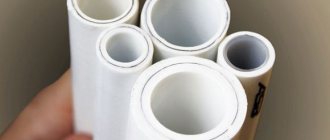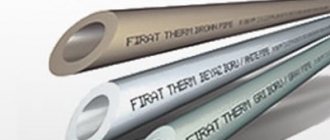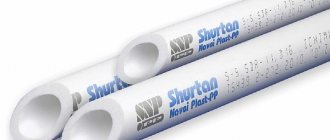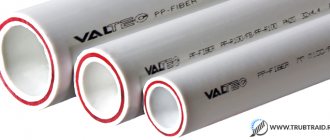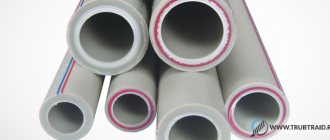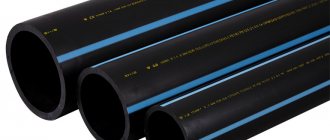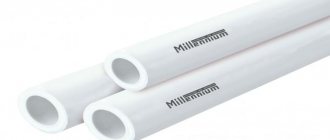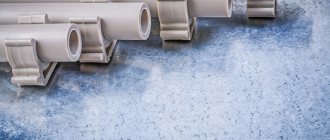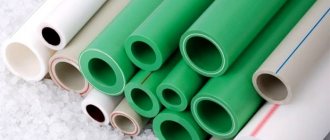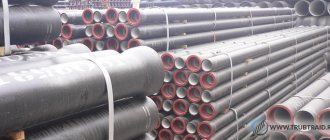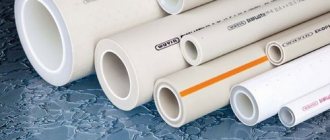With the development of technology, new materials appear on the market that are superior in their characteristics to their predecessors. In the field of communications, old metal pipes are being replaced by modern ones made on the basis of polymers.
One of the most popular materials in heating systems and water supply is polypropylene (PPR in the Russian abbreviation or PPR in the international marking). Polypropylene pipes have a number of advantages, due to which builders are increasingly leaning toward them when laying sewerage and heating systems.
Areas of application of PPR pipes
Polypropylene pipes are used in the installation of communication systems of residential buildings, public buildings, as well as technical and industrial buildings:
- for supplying drinking water,
- in cold water supply,
- for supplying hot water,
- in central heating of premises,
- for installation of heated floors and walls,
- in irrigation of farmland,
- at industrial enterprises,
- in fire safety systems,
- in swimming pools and other sports facilities,
- in shipping and so on.
Depending on the diameter of the pipe and the presence of additional layers, polypropylene products are used for laying both household pipelines and highways.
Where are PPR fittings used?
The abbreviation PPR indicates that the fittings are made from polypropylene (this is a type of plastic characterized by special elasticity that can withstand various external influences). PPR differs from other plastics in that it is “not afraid” of a wide variety of temperatures, ranging from 0 to +130 ° C. Thus, PPR fittings and pipes are excellent for heating system equipment.
However, let’s make a small amendment: if we are talking about installing a heating system in particularly cold regions, then instead of PPR fittings and pipes it is better to use others, since the temperature of the working environment in such conditions can reach +150 °C.
Installation of PPR pipes is carried out only by welding. If you want to use any other method to connect them, do not expect that you will get a sealed seam.
In order for the pipes to be as strong and stable as possible, internal reinforcement is used. Thus, an additional layer of foil (or other material) appears in the PPR pipe.
Before you start welding PPR pipes and fittings, you need to check whether the products are reinforced or not, since an additional layer of foil can interfere with creating a reliable connection.
Read material on the topic: Fittings for polypropylene pipes wholesale
Types of PPR pipes
There are several types of polypropylene pipes:
- PN 10 is a product with thin walls that can be used for cold water supply or installation of heated floors. The water temperature should not exceed +45°C. Such a pipe can withstand pressure up to 1 MPa (10.2 kg/cm²). This option is very convenient if only cold water will be supplied through the pipeline, since a thin-walled product requires the least resources for production, and therefore costs less than other types of PPR pipes. PN 10 pipes are manufactured with a diameter from 20 mm to 110 mm, with a wall thickness of 2.3-10 mm. The standard pipe length is 4 m.
- PN 16 has thicker walls and can be used to supply both cold and hot water (but the temperature must be below +60°C). Working pressure in PN 16 pipes is up to 1.6 MPa (16.32 kg/cm²). On average, the wall thickness of such a product is 0.5 mm greater than that of PN 10, which allows it to transport liquids of higher temperatures.
- PN 20 is used to supply hot water (up to +80°C) and can withstand pressure up to 2 MPa (20.4 kg/cm²). This product has much thicker walls, up to + 1 mm compared to PN 10.
- PN 25 are polypropylene pipes that can withstand temperatures up to +95°C, and therefore are used in hot water supply and heating systems. Working pressure - up to 2.5 MPa (25.49 kg/cm²).
We recommend that you read: Service life and capabilities of polypropylene pipes
Pipes marked above PN 20 are usually made of reinforced polypropylene, which provides additional rigidity and reliability of the product.
Advantages and disadvantages of PPR fittings
By purchasing high-quality PPR fittings, you can be sure that they will cope with all assigned tasks over a long period of operation. These qualities are now very highly valued when installing water supply and heating systems.
Main advantages
PPR fittings:
- ease of installation;
- the range is very wide;
- the most affordable price compared to similar products;
- duration of operation;
- not subject to corrosion and negative external influences;
- characterized by maximum thermal expansion, which is very important when there are significant temperature changes;
- can be operated at different temperatures.
PPR fittings have almost no disadvantages. Moreover, it can be said that there are no analogues for them.
Despite the above, we still present the most noticeable shortcomings
PPR fittings:
- there is a possibility of weld rupture over time;
- there is a possibility of purchasing low-quality products;
- couplings have a relatively low lifespan for going through freezing cycles.
Read material on the topic: Pipeline fittings
What do the inscriptions on pipes mean?
All modern polymer pipes are marked in the form of a set of letters and numbers in which the technical characteristics of the product are encoded:
- Manufacturer's company name.
- The material from which the pipe is made (H - homopolymer, R - random copolymer, PP - polypropylene, PPR - random polypropylene; S - single-layer pipe, M - has two or more layers, TI - with thermal insulation, HI - fire-resistant, etc.).
- Nominal pipe pressure (PN).
- Diameter and wall thickness of the pipe (in millimeters). For example, the value 25x4.2 indicates that the pipe diameter is 25 mm and the wall thickness is 4.2 mm.
- Operation class: class 3 - for cold water supply and heated floors, class 4 for temperature environments up to 70 ° C, class 5 - for hot water supply and space heating.
- Maximum permissible operating pressure.
Also, sometimes there is additional information on the pipes, for example, the production date, batch number, information about product certification, etc.
Let's investigate
Chemists know three modifications of polypropylene.
If you arrange them according to the time of creation, then these are:
- Propylene homopolymer PPH;
- PPB block copolymer;
- Static copolymer of propylene and ethylene. Poly Propylene Random Copolymer. P.P.R.C.
That's the news! And where, in fact, is the PPR pipe we are used to? What is it made of?
Everything is extremely simple. PPR pipes are made from the same PolyPropyleneRandomCopolymer. It’s just that in the process of market formation, branding of material and pipes, the established abbreviation decreased by one letter y.
The market generally gravitates towards short names and abbreviations. Few people remember that aspirin is correctly called acetylsalicylic acid.
Please note: you can often find another product of free word formation - PPRS pipes.
Apparently the latter is short for the wrong copolymer. Or maybe this is a reverse transliteration of the Russian-language PPRS... One way or another, it’s still the same polypropylene.
Before us is an old friend
Reinforced polypropylene pipes
It is important to understand that polypropylene is a type of plastic, which means the material is subject to thermal expansion. To avoid deformation of pipes and loss of their functionality and aesthetic appearance, it is necessary to use reinforced products to supply hot media.
PPR pipes reinforced with glass fiber
This polypropylene pipe consists of three layers:
- internal PPR,
- fiberglass,
- external PPR.
This technology provides additional rigidity to the product, reduces the heat loss coefficient and prevents thermal expansion. Thanks to these characteristics of PPR, fiberglass pipes can be used to supply hot water and in heating systems.
An additional advantage is the possibility of laying under finishing materials (unlike reinforced products, conventional PPR, when expanded, can lead to cracks in the plaster). Reinforcement also allows them to withstand greater pressure, and therefore such pipes can be used in main networks.
We recommend that you read: Replacing old pipes with polypropylene on your own
PPR pipes reinforced with aluminum foil
Polypropylene pipes with aluminum reinforcement also have 3 layers, however, instead of fiberglass, aluminum foil is laid between the PPR layers. This rigid design, in addition to resisting thermal expansion, provides additional resistance to mechanical damage.
There is also a type of reinforcement where aluminum foil is the outer layer. Such products require preliminary cleaning in places where elements are welded, which increases installation time. This type of pipe is not very popular, although it has the lowest linear expansion coefficient.
Advantages of using PPR pipes for heating
Polypropylene pipes have become widespread due to a number of characteristics:
- long service life (from 50 years for hot media to 100 years for cold water);
- light weight of the finished structure, which does not require additional supports;
- low heat loss coefficient;
- high level of sound insulation (PPR pipes are less noisy than metal ones);
- no condensation on the pipe;
- resistance to temperature changes;
- less chance of sediment settling inside the pipe;
- corrosion resistance;
- immunity to penetration of microorganisms;
- high installation speed;
- no need for additional pipe maintenance (painting, rust removal);
Despite all the advantages of PPR pipes, it is important to consider two points. Polypropylene is not resistant to UV rays, so it requires additional protection for outdoor use (an outer reinforced layer solves this problem).
Also, non-reinforced products have a high coefficient of linear expansion, therefore, if they are used to transport water with a temperature above +60 ° C, the pipes will be deformed (will go in waves). This will ruin the aesthetic appearance of the exposed piping and may ruin the finish if the pipes are hidden underneath.
Polypropylene pipes can withstand a short increase in the temperature of transported water up to +170 °C without deformation. However, if such cases occur regularly, it is better to replace the pipeline with a more suitable one.
Polypropylene and its physical and operational properties
Polypropylene is a product of polymerization (repeated addition to the crystal lattice of molecules of a low molecular weight substance) of propylene - a colorless, tasteless gas with a slight unpleasant odor.
The process occurs in the environment of catalysts, the chemical composition of which determines the type of substance produced. As a result, the output is white powder or granules with a filling density of 0.4-0.5 g/cm³.
Polypropylene raw materials can be colored, undyed or produced in a stabilized form.
Main physical and operational characteristics of polypropylene (CH3):
- It is environmentally friendly and harmless.
- Abrasion resistant.
- Neutral to most aggressive chemicals, compared to low-density polyethylene (HDPE) and less susceptible to cracking in an acidic environment. Due to the material’s resistance to many alkalis and acids, many foreign manufacturers produce pipes from it for the chemical industry.
- All polypropylenes, like most plastics, degrade when exposed to direct ultraviolet radiation.
- Polypropylene has high oxygen permeability and thermal linear expansion coefficient.
- Resistance to high temperatures;
- Noise-absorbing properties;
- Absolute corrosion resistance;
- Simple installation and repair work;
- Thermal insulation properties;
Rice. 2 Physical and mechanical properties of PPR
- Thanks to the smooth surface of parts made from polypropylene raw materials, PP pipes have a fairly low hydraulic resistance of the internal walls. Also, due to the lack of surface roughness, parts made of polypropylene are practically impossible to glue.
- To prevent oxygen and ultraviolet destruction of polypropylene, increase operating temperature thresholds and service life, stabilizers are introduced into its structure.
- PPR has low moisture absorption of the order of 0.03% for 30 days at 20 °C.
There are three main types of polypropylene:
Atactic (AP) is a soft elastic rubber-like material, inferior in its operational and physical characteristics to natural and synthetic rubbers. It often takes a liquid, oily or waxy form and is considered a by-product in many industries. After processing, it is widely used in the manufacture of various liquid building materials - bitumen, mastics, adhesive tapes, putties, primers.
Syndiotactic (SPP) is a harder material compared to atactic, melts at temperatures from 161 to 186 ° C (depending on the degree of tacticity). Used in the production of insulation for electrical, high-voltage wires, and multi-core cables.
Isotactic (IPP). It has three crystalline modifications α-, β- and γ, with the first being predominant. A material with an α-crystalline structure has a melting point of 185 to 220 °C and a density of 0.936 to 0.946 g cm-3. Isotactic polypropylene is widely used in the national economy. It is used to produce fabrics, tableware, rigid parts for various industries, insulating building materials and polypropylene pipes.
To impart frost resistance and elasticity, molecular ethylene CH2 is added to the IPP crystal lattice, thus obtaining a copolymer.
Rice. 3 Crystal lattices PP-H, PP-B and PP-R, respectively, without CH2 molecules, with ordered and random chains of CH2 ethylene molecules
There is an improved highly isotactic polypropylene HIPP with higher physical characteristics, from which the following block copolymers are made:
PP-N (1 - type) - pure polypropylene CH3 (PP homopolymer) without additives of molecular polyethylene (PE). The material is fragile, has a maximum permissible operating temperature range from 0 to 140 ° C, that is, it crystallizes at 0 ° C and softens at 140 ° C. PP-N is used for the manufacture of containers and non-pressure pipes used inside buildings.
PP-B (type 2) is a block copolymer of polypropylene with the addition of regularly alternating chains of CH2 polyethylene molecules. PP-B crystallizes at a temperature of - 20 ° C and softens at + 160 ° C, it is more elastic and resistant to thermal-oxidative destruction. Pipelines made from PP-B can be used in cold pressure water supply and low-temperature heating systems.
PP-R (3 - type) is a random copolymer of propylene (random - random, disorderly) with a chaotic or irregular alternation of added polyethylene molecules CH2. PP-R is even more elastic, its softening temperature is higher than + 170 °C. The maximum operating temperature of PP-R, depending on the manufacturer, is 90 or 95 °C.
PPR-CT (4 - type) - heat-stabilized polypropylene, having a larger number of faces in the lattice crystals. Thanks to this, it was possible to reach its upper temperature threshold for short-term operation of 100 - 110 ° C (depending on the brand).
Rice. 4 Crystal structure of PP-RCT and its advantages over conventional PP-R
Related article:
Soldering table for polypropylene pipes and heating temperature . If you are reading about polypropylene pipes, it may be interesting to read about the heating temperatures and cooling times of polypropylene fittings and pipes. All information is in a separate article.
